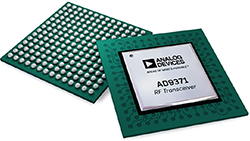
The nature of wireless communications is changing. The number of antennas is exploding in the never-ending search for improved spectral efficiency and range. Band proliferation in cellular wireless is increasing network capacity — but also interference. There is a boom in ISM-band applications and air interface standards. Even applications such as wireless video for drones need improved RF performance to tolerate increasing interference and avoid dreaded “fly aways.” Wireless connectivity is taken for granted — it’s expected to be everywhere, on all the time and on a very fast pace of evolution.
The traditional IF radio architecture is struggling to keep up. The number of discrete components and band-specific filters slows development time, and it’s increasingly hard to find a workable frequency plan. These challenges require not only radio solutions with breakthrough versatility and performance but also an ecosystem of development tools to get products to market with the speed that today’s world demands.
Based on innovative transceiver architectures and advanced digital algorithms, Analog Devices (ADI) is leveraging its silicon design and system expertise to shift focus to what matters most: reducing system cost while reducing the time to get a product to market. ADI’s RadioVerse™ technology and design ecosystem provide customers with integrated transceiver technologies, a robust design environment and market-specific technical expertise to quickly move their radio designs from concept to creation.
The foundation of the RadioVerse technology and design ecosystem is zero IF (ZIF) transceiver technology with breakthrough performance. In a ZIF receiver, the desired RF signal — or band — is down-converted directly to baseband. Likewise, in the transmitter, the digital baseband signal is converted directly to RF. The advantages are profound:
- Band-specific IF filters on the PCB are eliminated. Instead, on-chip high dynamic range analog-to-digital converters (ADC) and digital filters, which benefit from Moore’s Law, are optimally configured in software for each application.
- Clocking the ADCs, digital-to-analog converters (DAC) and digital at the lowest possible rate results in the lowest possible power dissipation.
- There are no out-of-band impairments such as images, N x M mixing products or aliases which increase RF filter rejection requirements.
- In addition to bandwidth agility, ZIF maximizes RF agility, since most of the signal processing is at baseband.
For these reasons, ZIF is the dominant radio architecture in consumer applications, such as cellular handsets and Wi-Fi. ADI’s transceivers bring this technology to applications requiring much wider bandwidth and dynamic range. Through heavy use of “digitally-assisted analog,” in-band impairments such as images are suppressed by more than 70 dB.
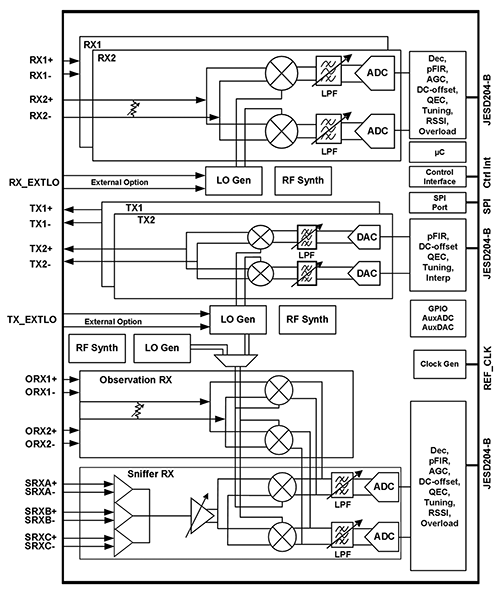
Figure 1 Functional block diagram of the AD9371 transceiver.
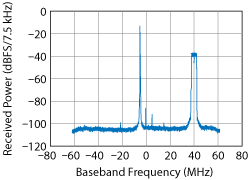
Figure 2 Linearity of the receiver portion of the AD9371, showing the performance of quadrature error correction.
The latest addition to ADI’s wideband transceiver family is the AD9371. This wideband transceiver covers 300 MHz to 6 GHz with 100 MHz signal bandwidth. The AD9371 is a highly integrated, RF agile transceiver offering dual channel transmitters and receivers, a two input observation receiver for digital predistortion (DPD) and power control, integrated synthesizers and digital signal processing functions (see Figure 1). The IC delivers a versatile combination of high performance and low power consumption and can operate in both half and full duplex non-contiguous multicarrier applications. Along with its predecessor, the AD9361 56 MHz RF transceiver, this family of products covers a wide range of applications, ranging from small cells, wireless pro audio and video, LTE macro base stations, portable signal analyzers and hand held and vehicle radios.
With the integration of the LO and high speed converter clocks, only a low frequency reference clock is needed, simplifying system clock generation and distribution. Monolithic integration enables the transceiver IC to be powered by few power rails: a typical configuration requires only three supplies (1.2 , 1.8 and 2.5 V). Eliminating additional power supplies decreases system cost and size and simplifies the PCB power plane decoupling design. The extremely low power consumption of the ADI transceivers eases thermal management, i.e., the need for heat sinking and other thermal management techniques — further reducing product size and development cost.
Figure 2 shows the performance of the AD9371 receiver with a -15 dB full scale (FS) CW input 5 MHz below the LO and a -10 dB FS (rms), 5 MHz wide LTE carrier that is 40 MHz above the LO, which is at 2.6 GHz. The advanced wideband quadrature error correction (QEC) algorithms simultaneously reject errors across the entire, wider bandwidth, resulting in nearly 80 dB rejection across temperature. Figure 3 shows the linearity performance of the transmitter, which has better than 60 dBc adjacent channel rejection with a 2.6 GHz, 20 MHz LTE waveform with 40 dBm total carrier power. The AD9371 transmitter is followed by power amplifier that delivers the +40 dBm output; the chain is linearized using the transceiver’s integrated observation receivers and a DPD algorithm.
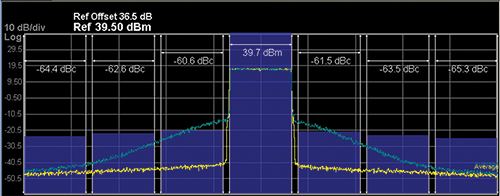
Figure 3 Linearity of the AD9371 transmitter portion with a 2.6 GHz, 20 MHz LTE signal.
ADI’s RadioVerse technology and design ecosystem will enable faster time to market (see Figure 4). A product like the AD9371 is necessarily complex, but ADI’s application programming interface (API) simplifies software integration by replacing complicated sequences of register writes with single high level commands. RadioVerse includes evaluation kits, development graphical user interfaces (GUI), simulation models, reference designs, best-of-breed partnerships, technical content for specific applications and access to ADI’s EngineerZone online technical community. The ecosystem is in place and growing, enabling engineers to harness the capabilities of ADI’s transceiver technology.
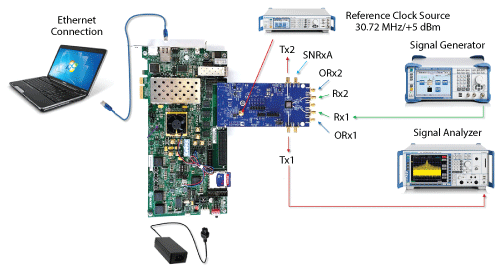
Figure 4 The AD9371 can be used with ADI’s evaluation software or custom code, including MATLAB and LabVIEW.
Analog Devices Inc.
Norwood, Mass.
www.analog.com
